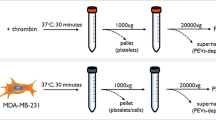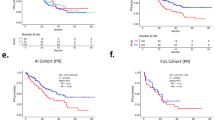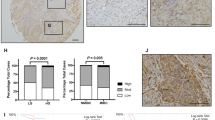Abstract
The prognostic value of tissue-type plasminogen activator (tPA) measured in samples derived from 865 patients with primary breast cancer using a recently developed enzyme-linked immunosorbent assay (ELISA) was evaluated. Since the assay could easily be adapted to the assessment of the complex of tPA with its type-1 inhibitor (PAI-1), it was investigated whether the tPA:PAI-1 complex also provides prognostic information. To this end, cytosolic extracts and corresponding detergent extracts of 100 000 g pellets obtained after ultracentrifugation when preparing the cytosolic fractions for routine steroid hormone receptor determination were assayed. Statistically significant correlations were found between the cytosolic levels and those determined in the pellet extracts (Spearman correlation coefficient rs = 0.75, P < 0.001 for tPA and r = 0.50, P < 0.001 for tPA:PAI-1 complex). In both Cox univariate and multivariate analysis elevated levels of (total) tPA determined in the pellet extracts, but not in cytosols, were associated with prolonged relapse-free (RFS) and overall survival (OS). In contrast, high levels of the tPA:PAI-1 complex measured in cytosols, but not in the pellet extracts, were associated with a poor RFS and OS. The prognostic information provided by the cytosolic tPA:PAI-1 complex was comparable to that provided by cytosolic (total) PAI-1. Furthermore, the estimated levels of free, uncomplexed tPA and PAI-1, in cytosols and in pellet extracts, were related to patient prognosis in a similar way as the (total) levels of tPA and PAI-1 respectively. Determination of specific forms of components of the plasminogen activation system, i.e. tPA:PAI-1 complex and free, uncomplexed tPA and/or PAI-1, may be considered a useful adjunct to the analyses of the separate components (tPA and/or PAI-1) and provide valuable additional prognostic information with respect to survival of breast cancer patients.
Similar content being viewed by others
Article PDF
Change history
16 November 2011
This paper was modified 12 months after initial publication to switch to Creative Commons licence terms, as noted at publication
References
Benraad, T. h. J., Geurts-Moespot, J., Grøndahl-Hansen, J., Schmitt, M., Heuvel, JJTM, De Witte, J. H., Foekens, J. A., Leake, R. E., Brünner, N. & Sweep, C. G. J. (1996) Immunoassays (ELISA) of urokinase-type plasminogen activator (uPA): report of an EORTC/BIOMED-1 workshop. Eur J Cancer 32A: 1371–1381.
Bradford, M. M. (1976) A rapid and sensitive method for the quantitation of microgram quantities of protein utilizing the principle of protein-dye binding. Anal Biochem 72: 248–254.
Butler, W. B., Kirkland, W. L., Gargala, T. L., Goran, N., Kelsey, W. H. & Berlinsky, P. J. (1983) Steroid stimulation of plasminogen activator production in a human breast cancer cell line (MCF-7). Cancer Res 43: 1637–1641.
Conese, M. & Blasi, F. (1995) Urokinase/urokinase receptor system: internalization/degradation of urokinase-serpin complexes: mechanisms and regulation. Biol Chem Hoppe-Seyler 376: 143–155.
Danø, K., Andreasen, P. A., Grøndahl-Hansen, J., Kristensen, P., Nielsen, L. S. & Skriver, L. (1985) Plasminogen activators, tissue degradation, and cancer. Adv Cancer Res 44: 139–266.
De Bruin, P. A. F., Griffioen, G., Verspaget, H. W., Verheijen, J. H., Dooijewaard, G., Van den Ingh, H. F. & Lamers, B. H. W. (1988) Plasminogen activator profiles in neoplastic tissues of the human colon. Cancer Res 48: 4520–4524.
De Witte, J. H., Sweep, C. G. J., Klijn, J., Grebenschikov, N., Peters, H., Look, M., Van Tienoven, T. h. H., Van Putten, W., Benraad, T. h. J. & Foekens, J. A. (1998). Prognostic impact of urokinase-type plasminogen activator (uPA) and its inhibitor (PAI-1) in cytosols and pellet extracts derived from 892 breast cancer patients. Br J Cancer (accepted for publication)
Dudani, A. K. & Ganz, P. R. (1996) Endothelial cell surface actin serves as a binding site for plasminogen, tissue-type plasminogen activator and lipoprotein(a). Br J Haematol 95: 168–178.
Duffy, M. J. (1996) Proteases as prognostic markers in cancer. Clin Cancer Res 2: 613–618.
Duffy, M. J., O’Grady, P., Simon, J., Rose, M. & Lijnen, H. R. (1986) Tissue-type plasminogen activator in breast cancer: relationship with estradiol and progesterone receptors. J Natl Cancer Inst 77: 621–623.
Duffy, M. J., O’Grady, P., Devaney, D., O’Siorain, L., Fennelly, J. J. & Lijnen, H. R. (1988) Tissue-type plasminogen activator, a new prognostic marker in breast cancer. Cancer Res 48: 1348–1349.
Duggan, C., Kennedy, S., Kramer, M. D., Barnes, C., Elvin, P., McDermott, E., O’Higgins, N. & Duffy, M. J. (1997) Plasminogen activator inhibitor type 2 in breast cancer. Br J Cancer 76: 622–627.
Egelund, R., Schousboe, S. L., Sottrup-Jensen, L., Rodenburg, K. W. & Andreasen, P. A. (1997) Type-1 plasminogen-activator inhibitor; conformational differences between latent, active, reactive-centre-cleaved and plasminogen-activator-complexed forms, as probed by proteolytic susceptibility. Eur J Biochem 248: 775–785.
EORTC Breast Cancer Cooperative Group (1980) Revision of the standards for the assessment of hormone receptors in human breast cancer; report of the second EORTC workshop, held on 16–17 March 1979, in The Netherlands Cancer Institute. Eur J Cancer 16: 1513–1515.
Foekens, J. A., Portengen, H., Van Putten, W. L. J., Peters, H. A., Krijnen, HLJM, Alexieva-Figusch, J. & Klijn, J. G. M. (1989) Prognostic value of estrogen and progesterone receptors measured by enzyme immunoassays in human breast tumor cytosols. Cancer Res 49: 5823–5828.
Grebenschikov, N., Geurts-Moespot, A., De Witte, H., Heuvel, J., Leake, R., Sweep, F. & Benraad, T. (1997) A sensitive and robust assay for urokinase and tissue-type plasminogen activators (uPA and tPA) and their inhibitor type I (PAI-1) in breast tumor cytosols. Int J Biol Markers 12: 6–14.
Grøndahl-Hansen, J., Bach, F. & Munckholm-Larsen, P. (1990) Tissue-type plasminogen activator in plasma from breast cancer patients determined by enzyme-linked immunosorbent assay. Br J Cancer 61: 412–414.
Hansson, P-O, Eriksson, H., Eriksson, E., Jagenburg, R., Lukes, P. & Risberg, B. (1994) Can laboratory testing improve screening strategies for deep vein thrombosis at an emergency unit?. J Int Med 235: 143–151.
Hekman, C. M. & Loskutoff, D. J. (1985) Endothelial cells produce a latent inhibitor of plasminogen activators that can be activated by denaturants. J Biol Chem 260: 11581–11587.
Jänicke, F., Schmitt, M., Hafter, R., Hollrieder, A., Babic, R., Ulm, K., Gössner, W. & Graeff, H. (1990) Urokinase-type plasminogen activator (u-PA) antigen is a predictor of early relapse in breast cancer. Fibrinolysis 4: 69–78.
Jänicke, F., Schmitt, M. & Graeff, H. (1991) Clinical relevance of the urokinase-type and tissue-type plasminogen activators and of their type-1 inhibitor in breast cancer. Semin Thromb Hemostas 17: 303–312.
Kaplan, E. L. & Meier, P. (1958) Non-parametric estimation from incomplete observation. J Am Stat Assoc 53: 457–481.
Layer, G. T., Burnand, K. G., Gaffney, P. J., Cederholm-Williams, S. A., Mahmoud, M., Houlbrook, S. & Pattison, M. (1987) Tissue plasminogen activators in breast cancer. Thromb Res 45: 601–607.
Levin, E. G., Santell, L. & Osborn, K. G. (1997) The expression of endothelial tissue plasminogen activator in vivo: a function defined by vessel size and anatomic location. J Cell Sci 110: 139–148.
Maser, R. E., Ellis, D., Erbey, J. R. & Orchard, T. J. (1997) Do tissue plasminogen activator-plasminogen activator inhibitor-1 complexes relate to the complications of insulin-dependent diabetes mellitus? Pittsburgh Epidemiology of Diabetes Complications Study. J Diabetes Complications 11: 243–249.
Mignatti, P. & Rifkin, D. B. (1993) Biology and biochemistry of proteinases in tumor invasion. Physiol Rev 73: 161–195.
Mira-Y-Lopez, R. & Ossowski, L. (1987) Hormonal modulation of plasminogen activator; an approach to predicting human breast tumor responsiveness. Cancer Res 47: 3558–3564.
Needham, G. K., Nicholson, S., Angus, B., Farndon, J. R. & Harris, A. L. (1988) Relationship of membrane-bound tissue type and urokinase type plasminogen activators in human breast cancers to estrogen and epidermal growth factor receptors. Cancer Res 48: 6603–6607.
Niwano, H., Takahashi, H., Tatewaki, W., Wada, K., Seki, Y. & Shibata, A. (1992) Behaviour of tissue plasminogen activator, plasminogen activator inhibitor 1 and their complex in various disease states. Blood Coagul Fibrinol 3: 389–393.
Rella, C., Coviello, M., Quaranta, M. & Paradiso, A. (1993) Tissue-type plasminogen activator as a marker of functional steroid receptors in human breast cancer. Thromb Res 69: 209–220.
Rijken, D. C. (1995) Plasminogen activators and plasminogen activator inhibitors: biochemical aspects. Baillière’s Clin Haematol 8: 291–312.
Schmitt, M., Jänicke, F. & Graeff, H. (1990) Tumour-associated fibrinolysis: the prognostic relevance of plasminogen activators uPA and tPA in human breast cancer. Blood Coagul Fibrinol 1: 695–702.
Schmitt, M., Harbeck, N., Thomssen, C., Wilhelm, O., Magdolen, V., Reuning, U., Ulm, K., Höfler, H., Jänicke, F. & Graeff, H. (1997) Clinical impact of the plasminogen activation system in tumor invasion and metastasis: prognostic relevance and target for therapy. Thromb Haemost 78: 285–296.
Yamashita, J-I, Ogawa, M., Yamashita, S., Nakashima, Y., Saishoji, T., Nomura, K., Inada, K. & Kawano, I. (1993) Differential biological significance of tissue-type and urokinase-type plasminogen activator in human breast cancer. Br J Cancer 68: 524–529.
Yamashita, J-I, Ogawa, M. & Sakai, K. (1995) Prognostic significance of three novel biologic factors in a clinical trial of adjuvant therapy for node-negative breast cancer. Surgery 117: 601–608.
Author information
Authors and Affiliations
Rights and permissions
From twelve months after its original publication, this work is licensed under the Creative Commons Attribution-NonCommercial-Share Alike 3.0 Unported License. To view a copy of this license, visit http://creativecommons.org/licenses/by-nc-sa/3.0/
About this article
Cite this article
Witte, J., Sweep, C., Klijn, J. et al. Prognostic value of tissue-type plasminogen activator (tPA) and its complex with the type-1 inhibitor (PAI-1) in breast cancer. Br J Cancer 80, 286–294 (1999). https://doi.org/10.1038/sj.bjc.6690353
Received:
Revised:
Accepted:
Published:
Issue date:
DOI: https://doi.org/10.1038/sj.bjc.6690353
Keywords
This article is cited by
-
Prognostic significance of VEGF and components of the plasminogen activator system in endometrial cancer
Journal of Cancer Research and Clinical Oncology (2020)
-
Expression and Clinical Signification of Cytosolic Hyaluronan Levels in Invasive Breast Cancer
Breast Cancer Research and Treatment (2006)
-
Tissue-Type plasminogen activator (tPA) in breast cancer: relationship with clinicopathological parameters and prognostic significance
Breast Cancer Research and Treatment (2005)
-
The Hemostatic System and Angiogenesis in Malignancy
Neoplasia (2001)



